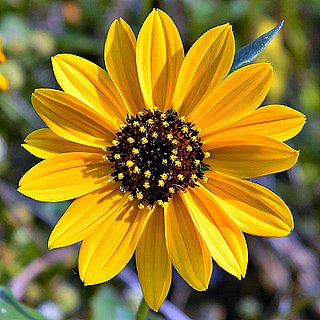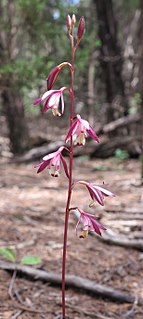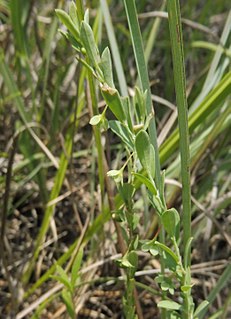Natural Resources Conservation Service (NRCS), formerly known as the Soil Conservation Service (SCS), is an agency of the United States Department of Agriculture (USDA) that provides technical assistance to farmers and other private landowners and managers.

Echium vulgare — known as viper's bugloss and blueweed — is a species of flowering plant in the borage family Boraginaceae. It is native to most of Europe, and western and central Asia and it occurs as an introduced species in north-eastern North America.

Phyllanthus emblica, also known as emblic, emblic myrobalan, myrobalan, Indian gooseberry, Malacca tree, or amla from Sanskrit amalaki is a deciduous tree of the family Phyllanthaceae. It has edible fruit, referred to by the same name.

Hexalectris is a genus of the family Orchidaceae, comprising 10 known species of fully myco-heterotrophic orchids. These species are found in North America, with the center of diversity in northern Mexico. None of the species are particularly common. Hexalectris spicata has a wide distribution and is likely the most abundant member of the genus, but is nevertheless infrequent throughout its range. Other species are rare, and some, such as H. colemanii, are threatened or endangered. All species that have been studied form associations with ectomycorrhizal fungi that are likely linked to surrounding trees. Many Hexalectris species are found in association with oak trees (Quercus), which are ectomycorrhizal.

Thelesperma filifolium, commonly known as stiff greenthread, or plains greenthread, is a species of flowering plant in the aster family, Asteraceae. It is often found growing in shallow soils. It prefers disturbed sites in dry, sandy or gravelly soil with a neutral to basic pH. Stiff greenthread adapts to various soil conditions, including loam, clay, caliche, and roadsides. It blooms between March and June and often into the fall.

Amaranthus caudatus is a species of annual flowering plant. It goes by common names such as love-lies-bleeding, pendant amaranth, tassel flower, velvet flower, foxtail amaranth, and quilete.

Prosopis glandulosa, commonly known as honey mesquite, is a species of small to medium-sized, thorny shrub or tree in the legume family (Fabaceae).

Lathyrus aphaca is a legume known as the yellow pea or yellow vetchling. It is native to southern Europe, parts of Asia, and North Africa. Some consider it to be a weed, particularly when in areas where it is an introduced species, including northern Europe and North America. It acclimates best to dry places, such as sand, gravel, and chalk, and requires a well-drained habitat. It is an annual herb producing yellow pea flowers just over a centimeter wide.

Dimorphotheca sinuata, the glandular Cape marigold, Namaqualand daisy, or orange Namaqualand daisy; syn. Dimorphotheca aurantiaca hort.) is an African species of plants native to southern Africa. It is also widely cultivated as an ornamental and naturalized in parts of the United States, primarily California and Arizona.

Orthilia is a genus of flowering plant in the family Ericaceae. It has only one species, Orthilia secunda. Its common names are sidebells wintergreen, one-sided-wintergreen and serrated-wintergreen. It is also called one-sided pyrola, one-sided shinleaf, and one-sided wintergreen. It was previously part of genus Pyrola, the wintergreens.

Tephrosia virginiana, also known as goat-rue, goat's rue, catgut, rabbit pea, and Virginia tephrosia, is a perennial dicot in family Fabaceae. This subshrub has alternate compound leaves. Its leaves are imparipinnate, with relatively wide pinnae. All parts of the plant are pubescent giving it a silvery, hoary appearance. The terminal, compact racemes of cream and deep pink flowers bloom May to August. This plant prefers acidic soils, in part to full sun. It grows throughout the Midwest, New England and southeastern United States. Not easy to propagate, this plant can be found in sand savannas, open woods and glades, prairies and rocky soils. All tissues of this plant are toxic, and should not be eaten by people or livestock. Crushed stems were previously used as a fish poison.

Erodium cygnorum is a species of herb native to Australia.

Parryella filifolia, the common dunebroom, is a species of flowering plants in the legume family, Fabaceae. It belongs to the subfamily Faboideae. It is the only member of the genus Parryella. Its ashes were sometimes used by members of the Hopi Tribe in the maize nixtamalization process and helped to retain the blue color of cornmeal used to make piki bread. The beans were also used as a remedy for toothaches.

Populus fremontii, commonly known as Fremont's cottonwood or the Alamo cottonwood, is a cottonwood native to riparian zones of the Southwestern United States and northern through central Mexico. It is one of three species in Populus sect. Aigeiros. The tree was named after 19th century American explorer and pathfinder John C. Frémont.

Thelesperma megapotamicum is a perennial species of flowering plant in the aster family known by the common name Navajo tea greenthread and rayless greenthread. It is native to sections of the Americas, including the central United States, where it grows in many types of habitat. It is a perennial herb producing a slender, branching stem 30 to 60 centimeters tall or more. The leaves are narrow, mostly compound with linear or threadlike segments measuring a few centimeters long. The inflorescence bears several flower heads each in a cuplike involucre of phyllaries with purple-tinged, pointed lobes with white edges. The head contains many yellow or orange disc florets, and sometimes one or more yellow ray florets, although these may be absent.

Hypericum cumulicola is a rare species of flowering plant in the St. John's wort genus known by the common name highlands scrub hypericum, or highlands scrub St. John's wort. It is endemic to Florida, where it is threatened by habitat loss and degradation. It is a federally listed endangered species of the United States.

Rhus kearneyi is a species of flowering plant in the cashew family known by the common name Kearney's sumac. It is native to western North America, where it can be found in Arizona in the United States and Baja California in Mexico.

Helianthus debilis is a species of sunflower known by the common names cucumberleaf sunflower, beach sunflower, weak sunflower, and East Coast dune sunflower. It is native to North America, where it can be found along the Atlantic and Gulf Coasts. It is known elsewhere as an introduced species, such as South Africa, Australia, Taiwan, Slovakia, and Cuba.

Hexalectris warnockii is a myco-heterotrophic orchid found in the states of Texas and Arizona in the southwestern United States, and in the states of Coahuila and Baja California Sur in northern Mexico. Being myco-heterotrophic, H. warnockii derives all of its nutrients from mycorrhizal fungi.

Phyllanthus polygonoides, known as smartweed leaf-flower or knotweed leafflower, is an herbaceous perennial plant in the family Phyllanthaceae. It grows from 10 to 50 centimeters in height. It is native to the United States and northern and central Mexico.



















